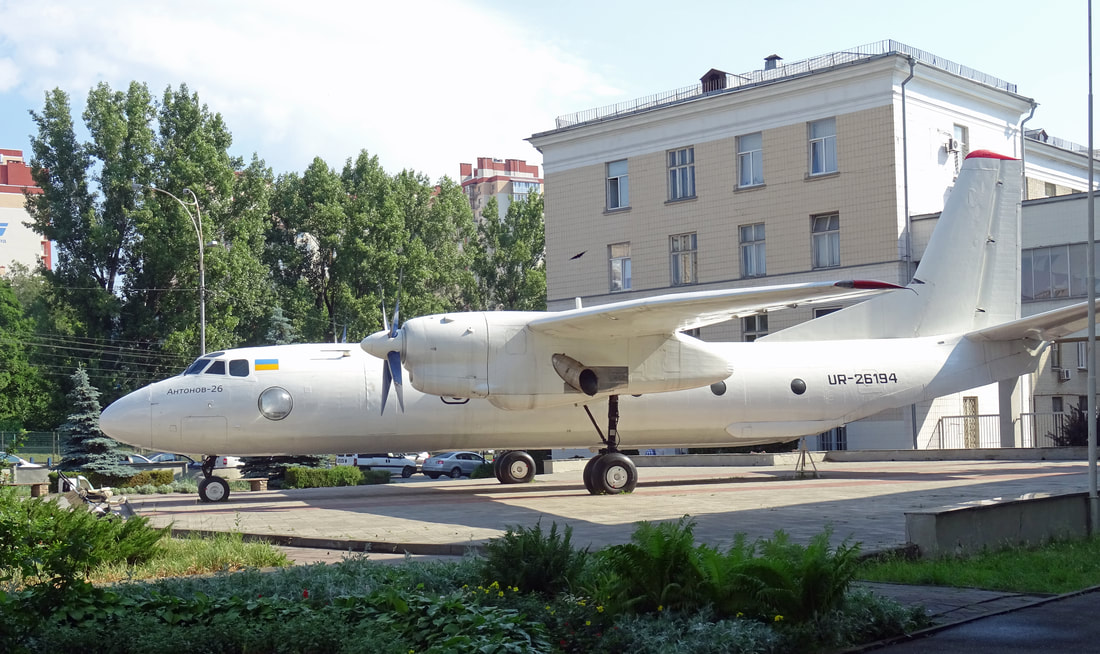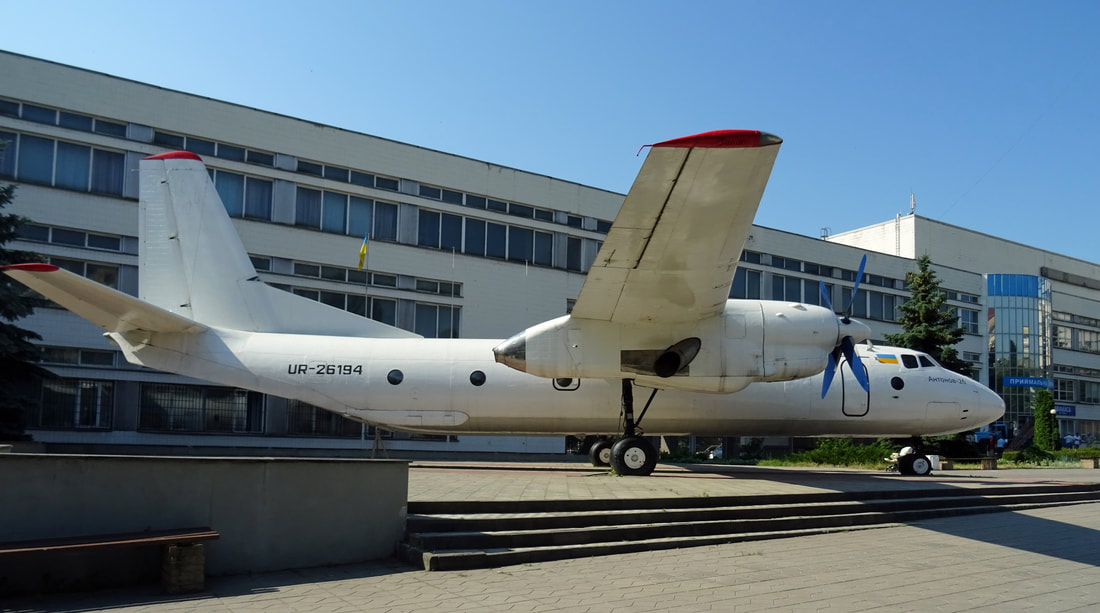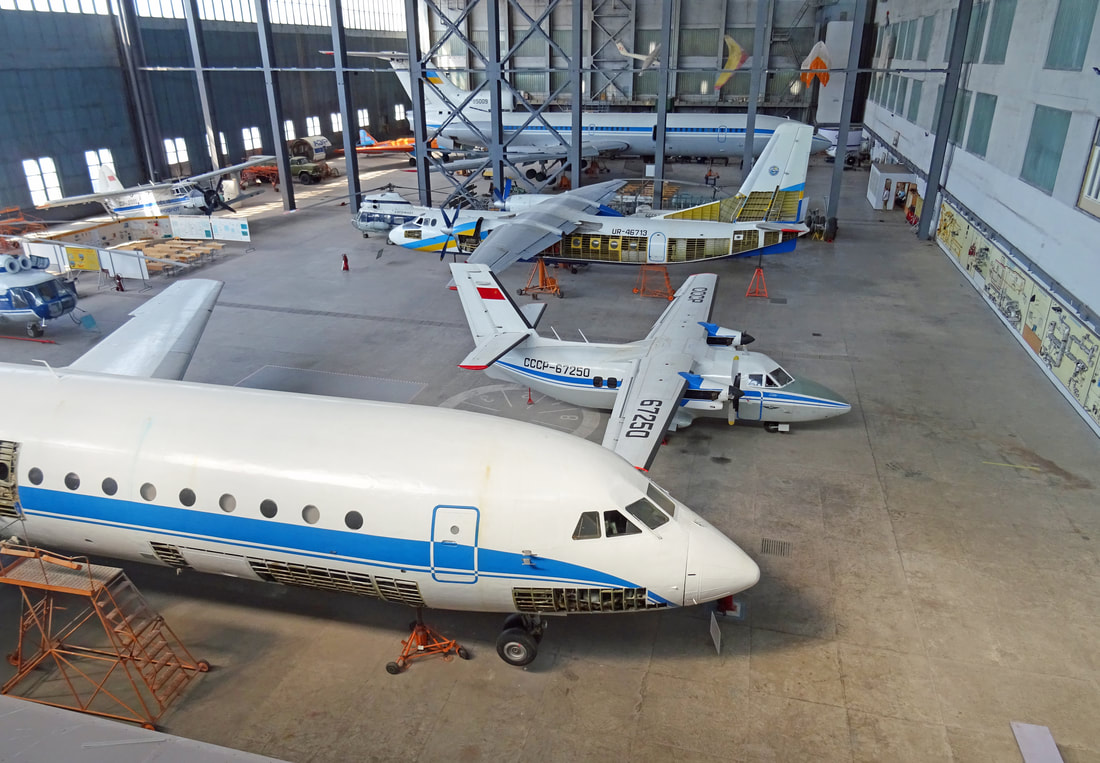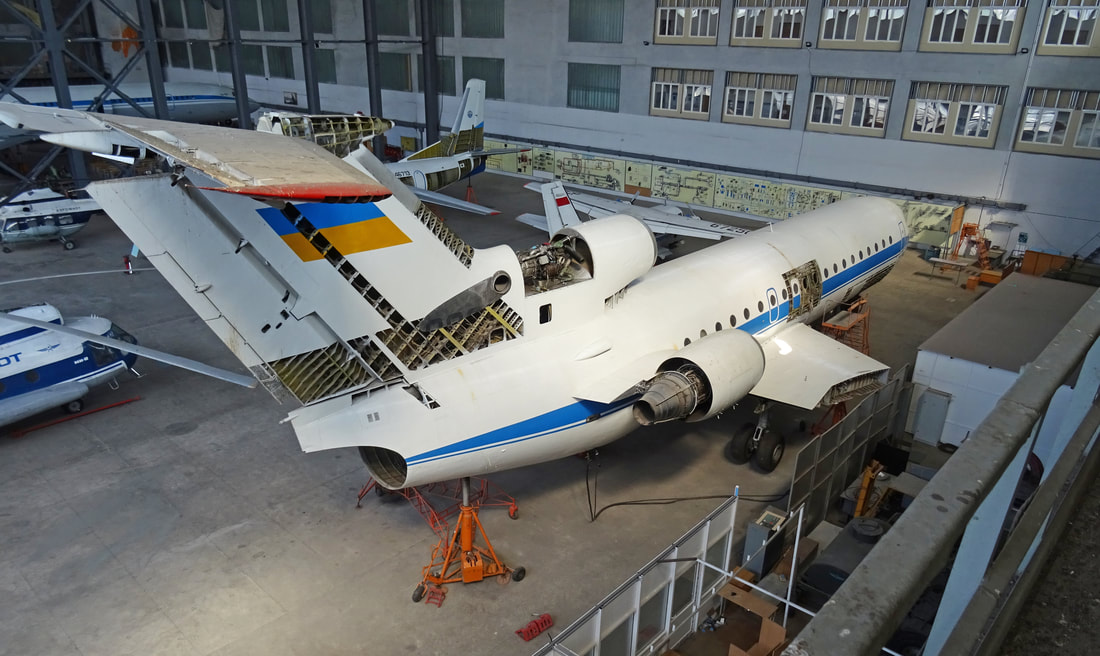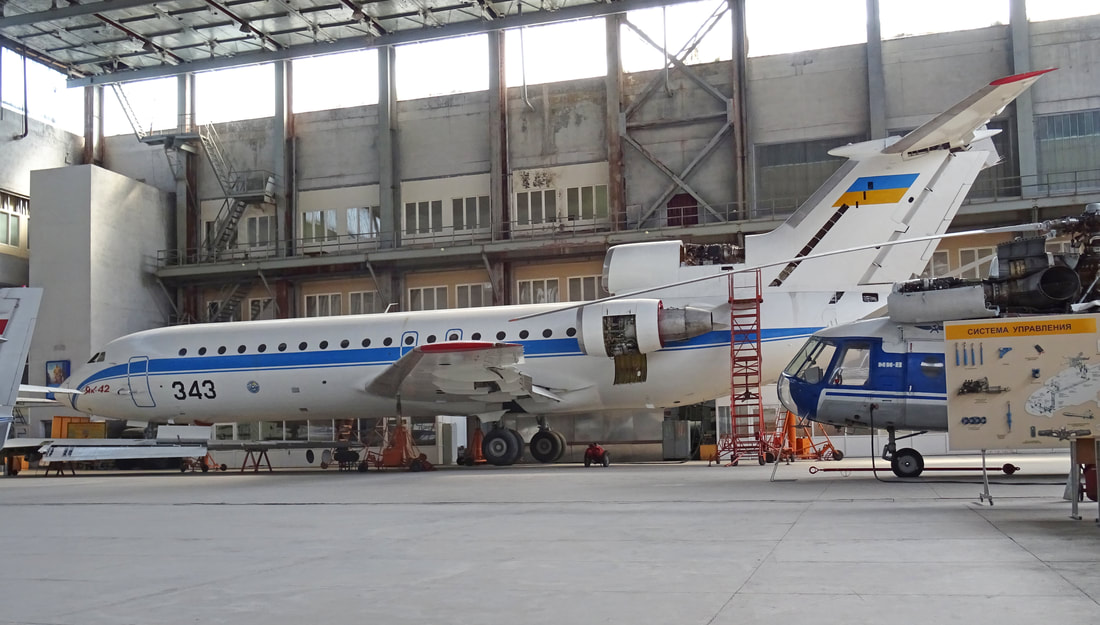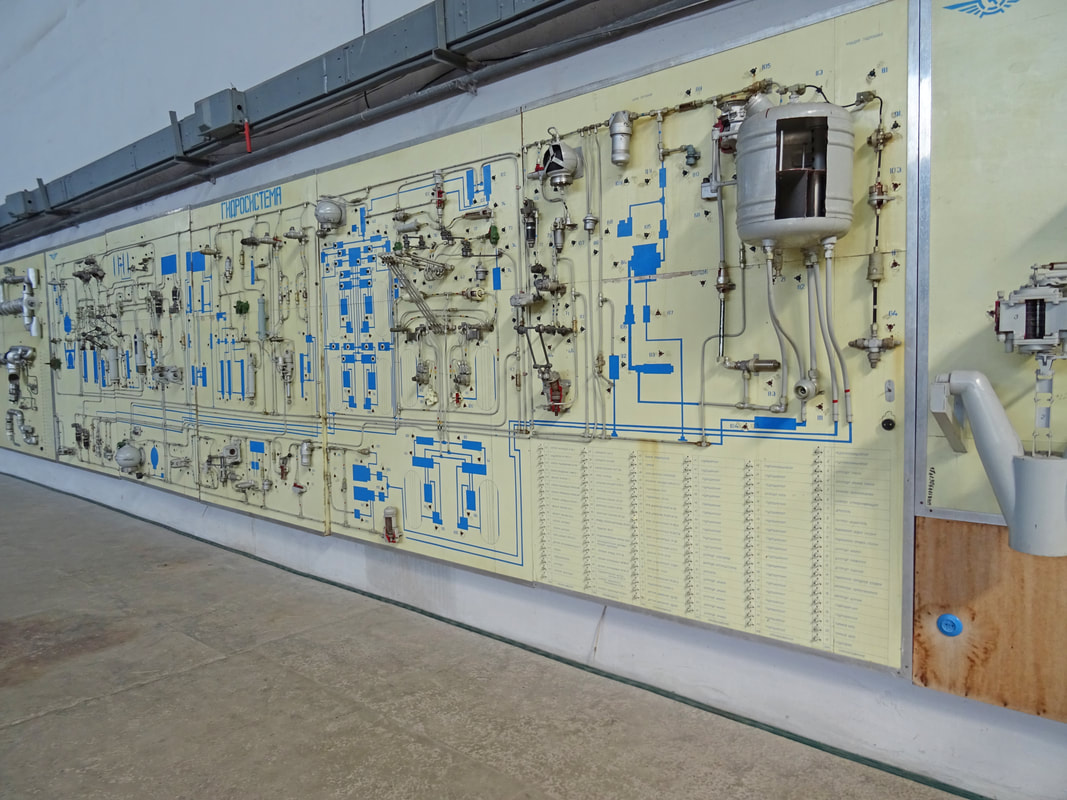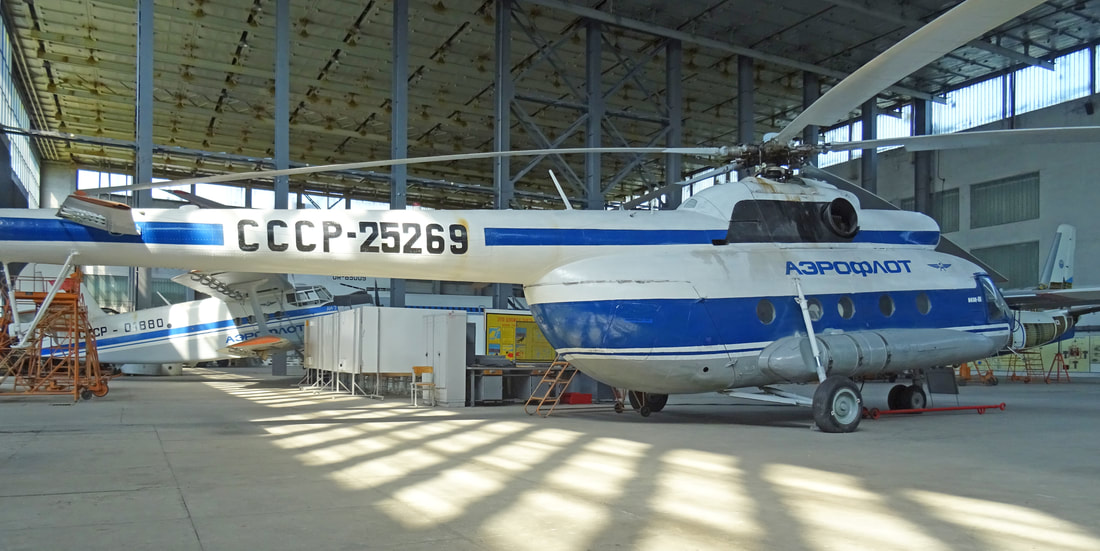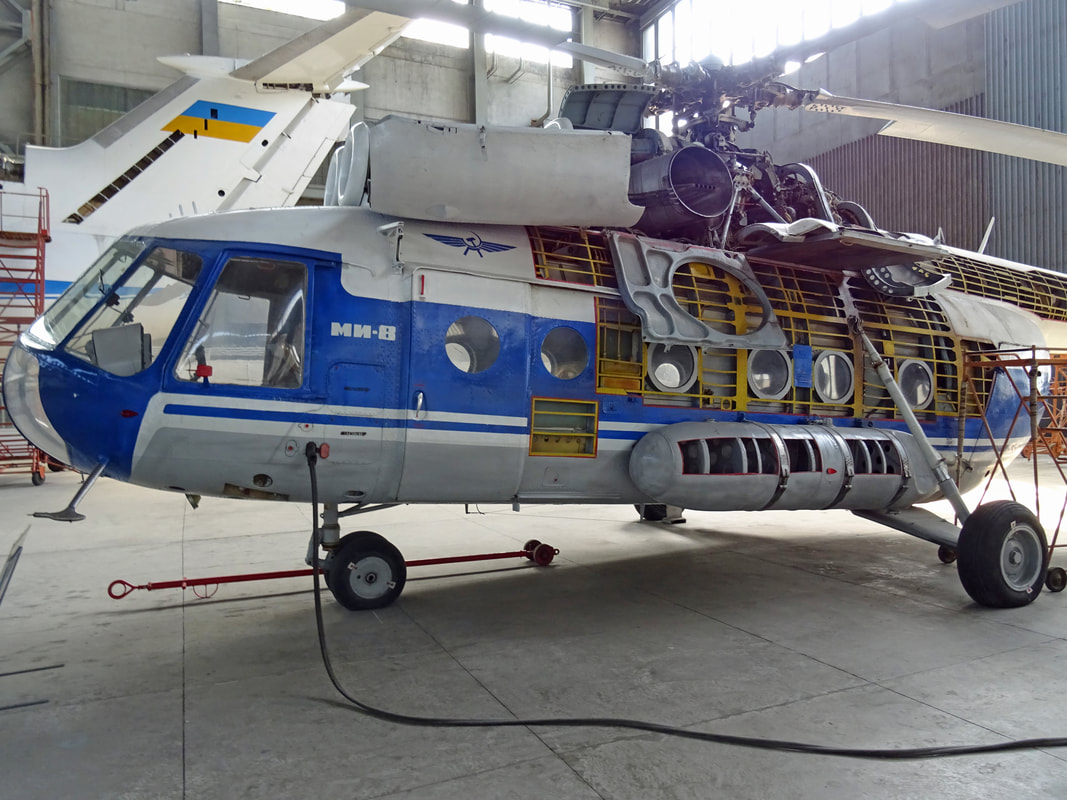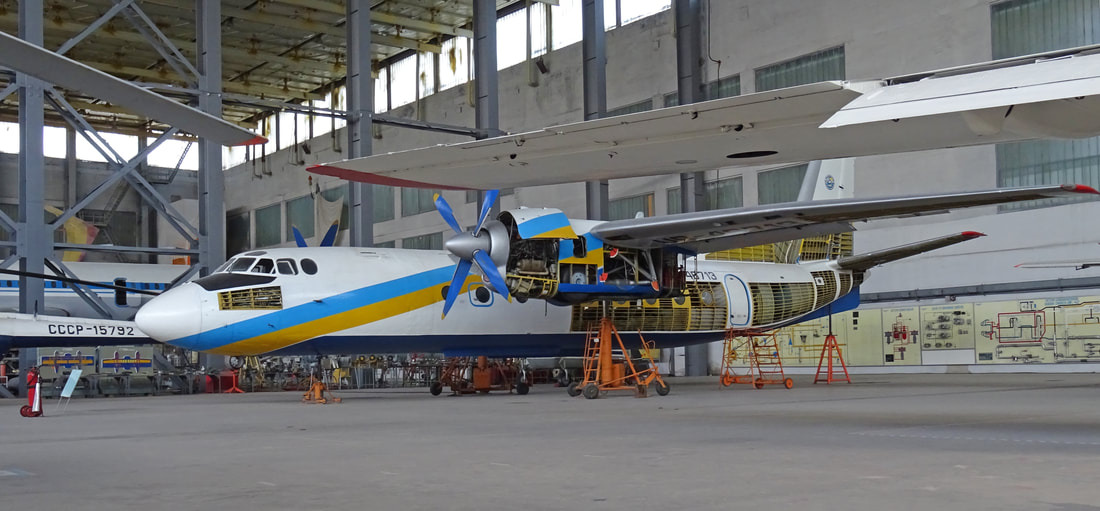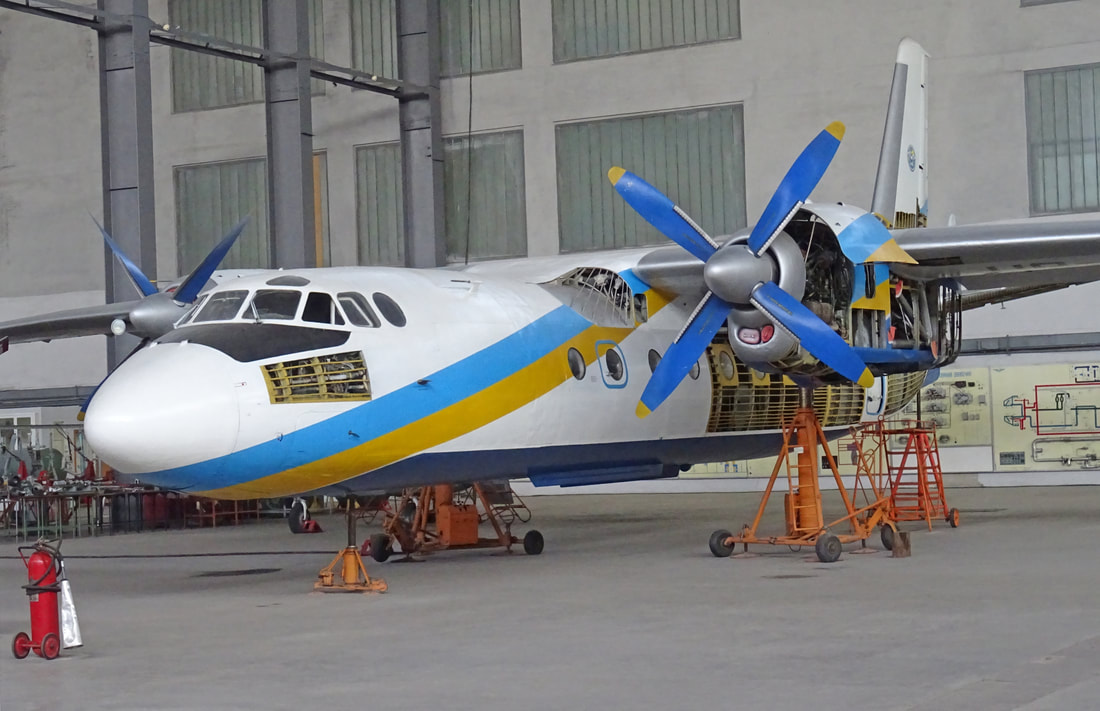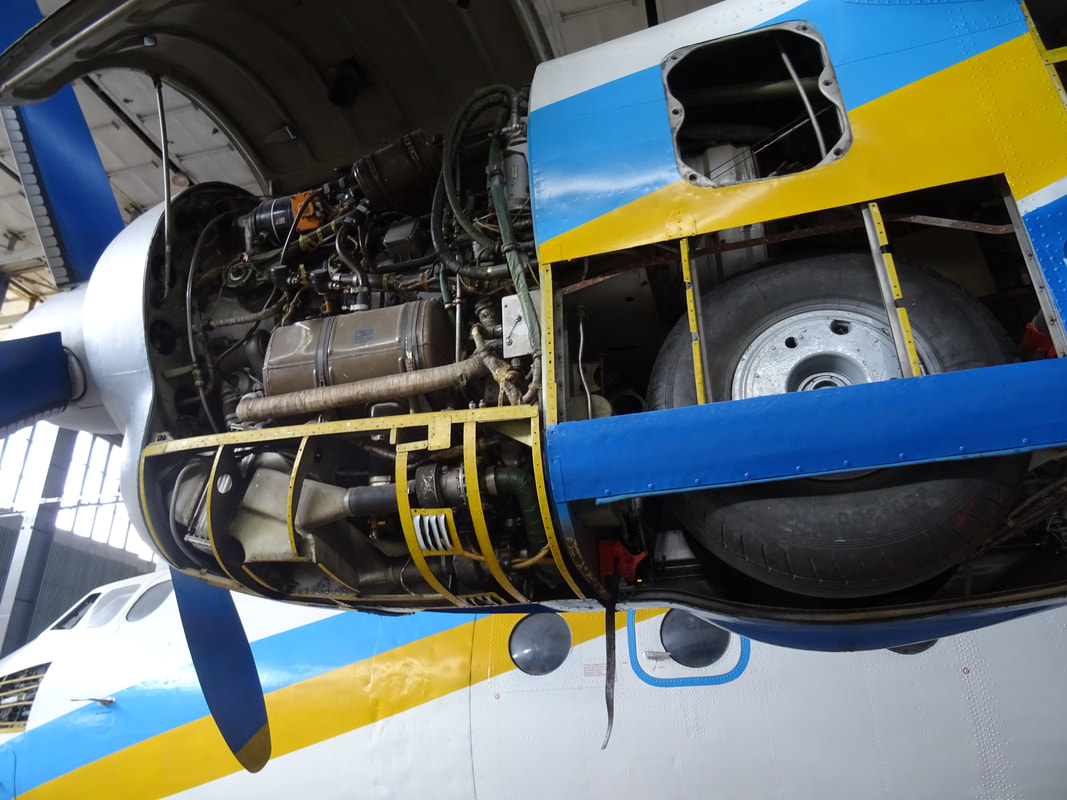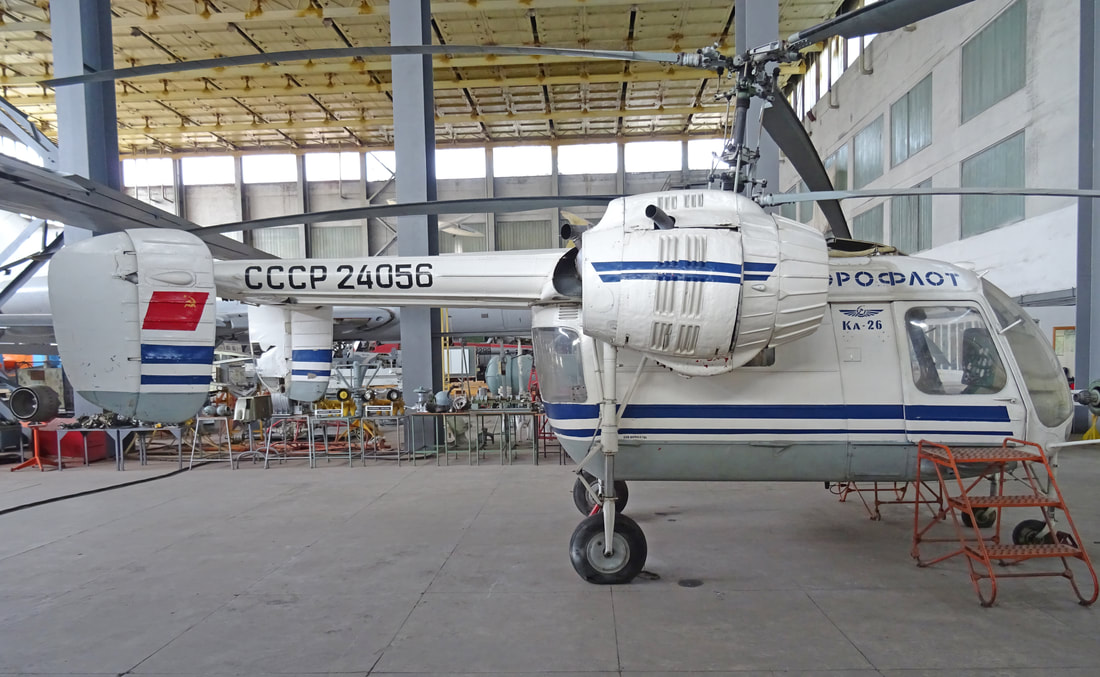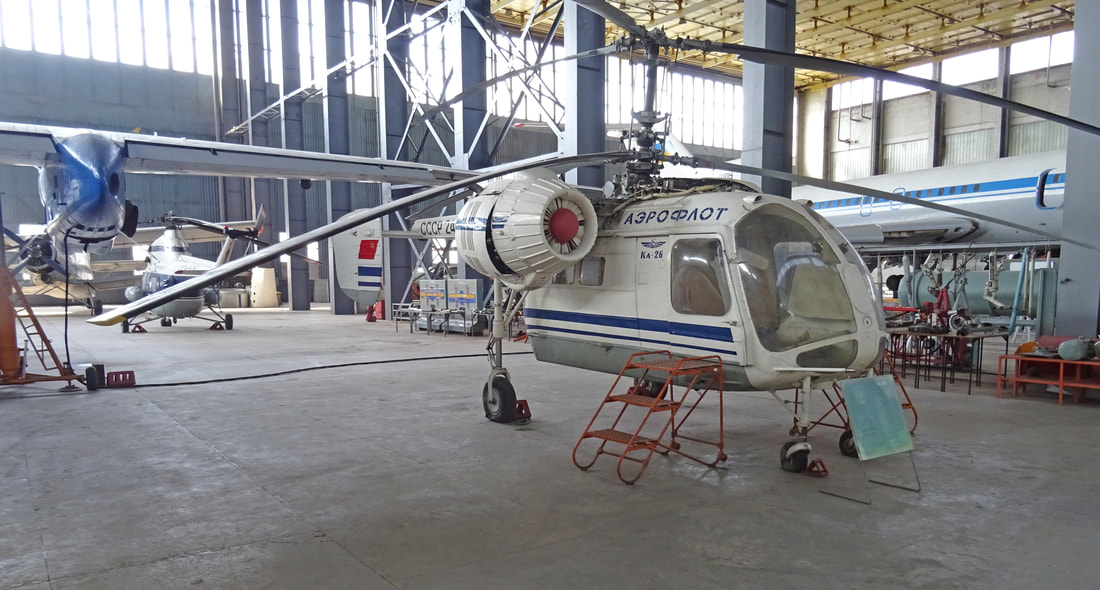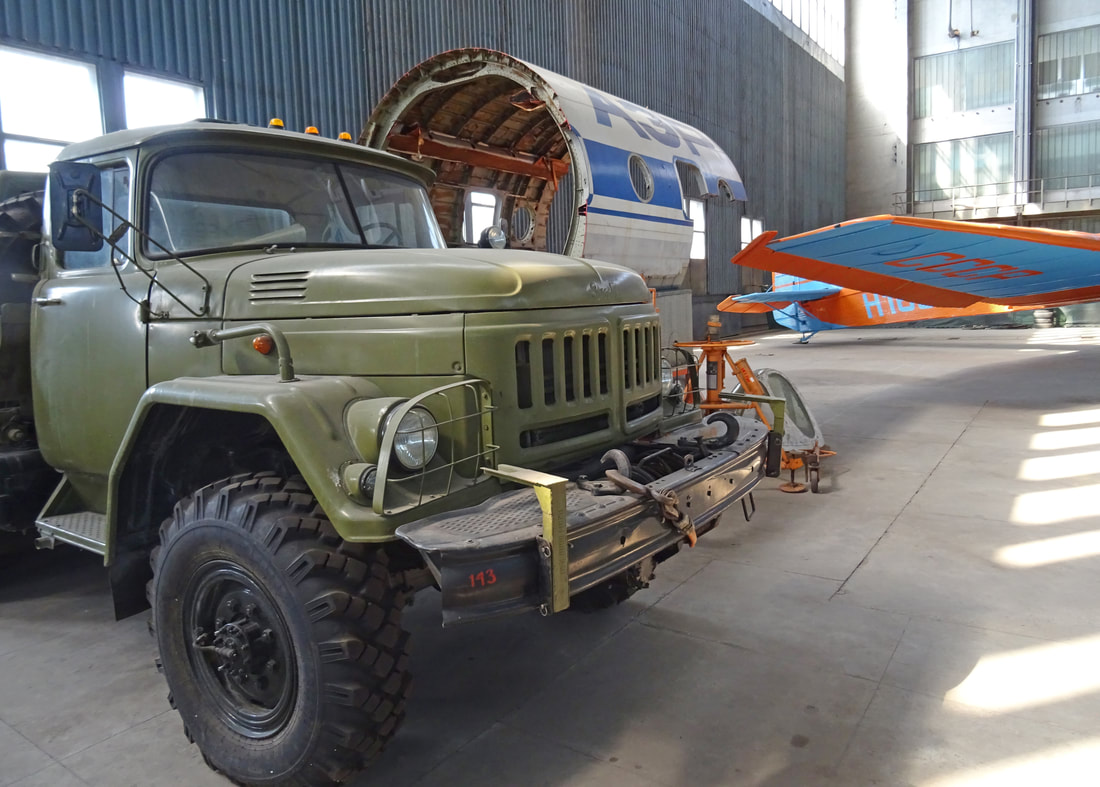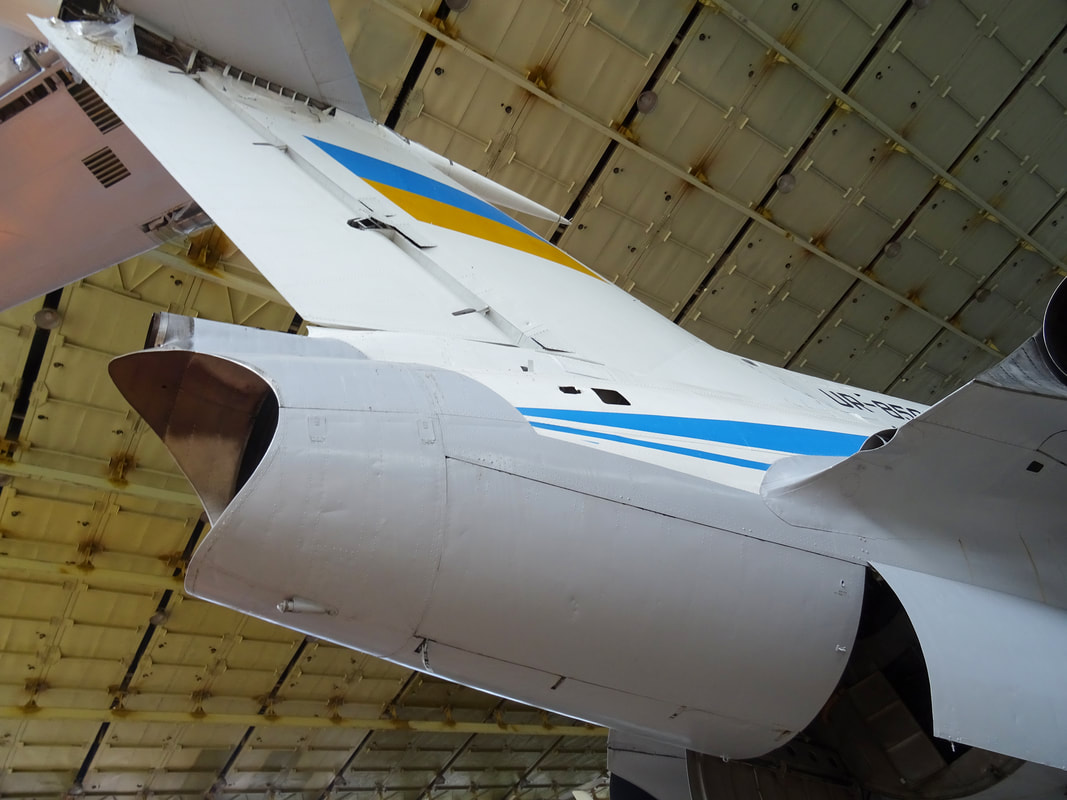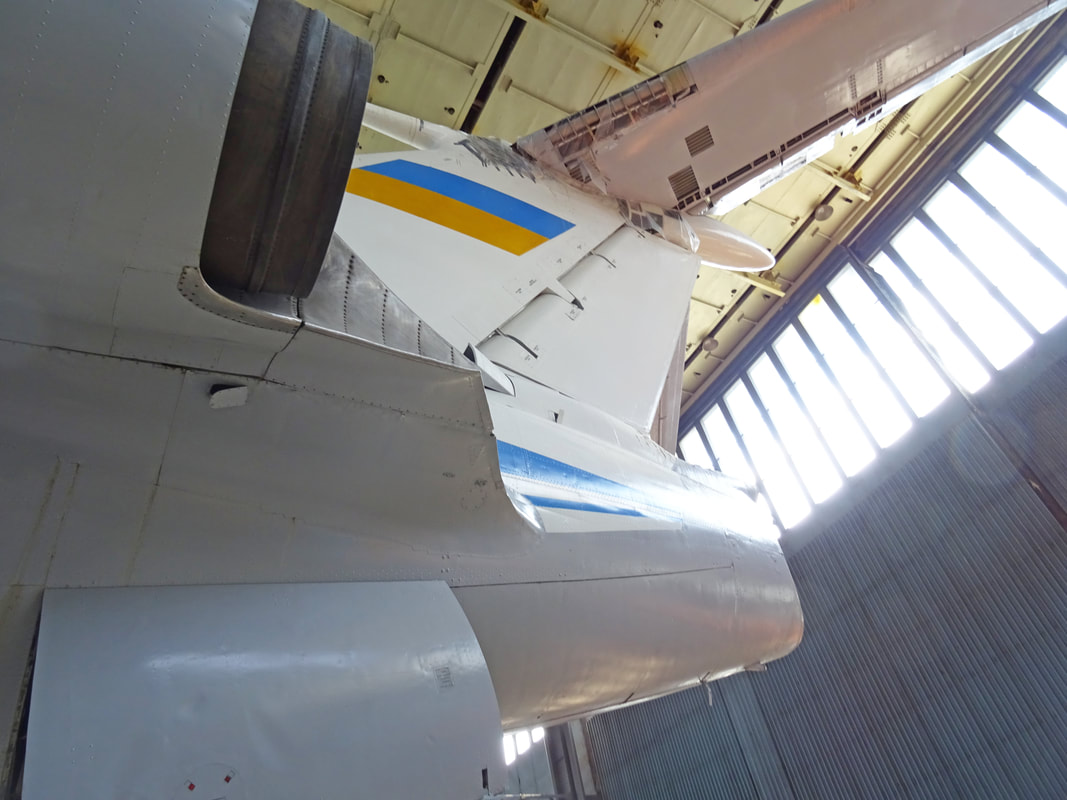Kiev National Aviation University
by Jan Koppen
On June 06, 2018, Paul Filmer and I, visited the National Aviation University, which is situated in the city center of Kiev.
UR-26194 is an Antonov An-26B (c/n. 0202) and seen here preserved in front of the entrance of the University campus.
A slightly dented skins evident on the fuselage in the plane of the propeller disc.
The An-26B is a civil cargo version equipped with roller gangways which can be swung up against the cabin walls when not in use. It was also equipped with two ZMDB Progress (Ivchyenko) Al-24VT turboprop powerplants to deliver higher thrust.
Some seriously fascinating stuff there.
|
Your author in the university hangar.
You would expect the Aviation University to be based at the Airport. This is not the case, it is situated in the City centre on Kosmonavta Komorova Avenue. As an aviation worker it was easy to get in and we had a very educational tour in the interesting training hangar.
|
Yakovlev Yak-42 CCCP-42303 (c/n. 01003). This is the third prototype and is a ground instructional airframe at Kiev National Aviation University.
The Yak-42 trijet was developed as a replacement for Tupolev's Tu-134 twinjet and Antonov's An-24 turboprop.
Two engines are mounted in pods on either side of the rear fuselage. The middle engine is at the end of an S-duct, embedded inside the rear fuselage, under the T-tail. An auxiliary power unit (APU) is also fitted in the rear fuselage. The aircraft lacks thrust reversers.
An auxiliary power unit (APU) is a device on a vehicle that provides energy for functions other than propulsion. They are commonly found on large aircraft and naval ships as well as some large land vehicles. Aircraft APUs generally produce 115 V alternating current (AC) at 400 Hz (rather than 50/60 Hz in mains supply), to run the electrical systems of the aircraft; others can produce 28 V direct current (DC). APUs can provide power through single- or three-phase systems.
Note;- The big hole on left on the pic is the outlet of the APU's fumes.
Note;- The big hole on left on the pic is the outlet of the APU's fumes.
This aircraft was one of the first Yakovlev Yak-42's built and was delivered to its first operator in November 1976 as a Yak-42D. She was donated to University in 1992.
'Sir Paul Filmer' in action at the National Aviation training hangar in Kiev's city center.
A moderately swept wing was a compromise between the need for good field performance and high speed cruise capabilities.
The Yak-42 features a three engine configuration for increased redundancy and good short field performance.
An integral airstair, APU and double main undercarriage are all incorporated into the Yak-42 design for austere airfield operations.
The Lotarev turbofan was one of the first true turbofans to be developed in the Soviet Union.
Early production example exhibited at the 1977 Paris Air Show.
This pre-production Yak-42 was on display at 'The 1977 Paris Airshow'.
Her registration was removed but she still wears her Paris airshow code 343.
CCCP-67250 is a Let410MU Turbolet.
Preserved in the education center of the Ukrainian National Aviation University in Kiev. The aircraft is in the perfect technical condition and has only 10 flight hours.
The National Aviation University houses an interesting training hangar.
How does it works!
Aeroflot Mil Mi-8 CCCP25269 is seen here in education center of Ukraine National Aviation University (Kiev city).
The Mil Mi-8 has large external fuselage tanks which can be removed easly.
The Klimov TV3-117 is a Russian gas turbine aero engine. It is used in most medium lift, utility and attack helicopters designed by the Mil and Kamov design bureaus. The TV3-117 turboshaft engine was developed in 1974. Later the Klimov TV3-117 was installed on 95% of all helicopters designed by Mil and Kamov Engineering Centre. The engine has been produced in many variants.
UR-46713 an Antonov An-24.
Due to its rugged airframe and good performance, the An-24 was adapted to perform many secondary missions such as ice reconnaissance and engine/propeller test-bed, as well as further development to produce the An-26 tactical transport, An-30 photo-mapping/survey aircraft and An-32 tactical transport with more powerful engines. Various projects were envisaged such as a four jet short/medium haul airliner and various iterations of powerplant.
Clearly visible in this picture is the starboard side of the An-24's twin ventral fins.
Ivchenko AI-24 turboprop aircraft engine was designed and developed in the late-1950s by the Ivchenko design bureau and manufactured thereafter by Motor Sich. It was designed to power Antonov's successful An-24, An-26 and An-30 aircraft series.
The hydraulically retractable tricycle type landing gear has twin wheels on each unit.
The Ivchenko is driving a constant-speed fully-feathering propeller.
The tail unit is coonventional, with the addition of a fairly large ventral fin.
Several engine fire-extinguishers are housed in the starboard engine nacelle.
Aeroflot Mil Mi-2 CCCP-15792.
Some of the aircraft inside the institutes hangar are still in working condition even though they haven't flown for years.
Aeroflot Antonov An-2 CCCP-01880.
This aircraft was manufactured and delivered to Aeroflot in 1961 as a An-2T. She was donated to University in 1977.
Aeroflot CCCP-24056 is a Kamov Ka-26.
Oleg Konstantinovich Antonov was a prominent Russian Soviet aircraft designer, and the first chief of Antonov - a world-famous aircraft company in modern day Ukraine, later named in his honour. Antonov was personally responsible for designing a number of very successful Soviet airplanes.
CCCP-02299 is a Mil Mi-4A Hound and its operator was the Kiev Institute of Civil Engineering.
This Mil Mi-4A was build in the Kazan helicopter plant No. 387.
Mil Mi-2 c/n. 521303119 is a ground instructional airframe at Kiev National Aviation University. She wears no registration but she can be identified from a plate inside her nose.
Two glazed fuselage noses of most probably the Tupolev Tu-134A linger in the training hangar of the University.
After 411 built aircraft between 1931 and 1934, this Tupolev ANT-7 (or Tupolev R-6), CCCP-H166, is the world's only surviving ANT-7.
UR-85009 is a Tupolev Tu-154.
Former registration was CCCP-65009. This aircraft is preserved in education center of Ukrainian National Aviation University in Kiev. The front cabin made to simulate emergency landing and used for trainings of students. The aircraft had never been used for carrying of passengers.
Airframe 70M009 was manufactured 1970 and delivered to Aeroflot on January 08, 1971.
This ship was donated to the University during in May 2002.
Note; - The easiest way to tell the A and B model from the base model is by looking at the spike at the junction of the fin and tail; this is a fat bullet on the A model rather than a slender spike on the base model.
|
The Tu-154 is powered by three rear-mounted low-bypass turbofan engines arranged similarly to those of the Boeing 727, but it is slightly larger than its American counterpart. Both the 727 and the Tu-154 use an S-duct for the middle (Number 2) engine. The original model was equipped with Kuznetsov NK-8-2 engines, which were replaced with Soloviev D-30KU-154 in the Tu-154M. All Tu-154 aircraft models have a relatively high thrust-to-weight-ratio which give excellent performance, at the expense of lower fuel efficiency. This became an important factor in later decades as fuel costs grew.
|
Russian hardware was capable of operating from unpaved and gravel airfields with only basic facilities. Such bogies were widely used in the extreme Arctic conditions of Russia's northern/eastern regions where other airliners were unable to operate
- The End -
